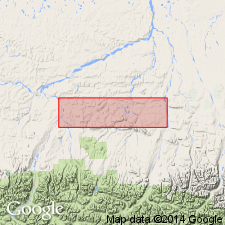
- Usage in publication:
-
- Killik tongue*
- Modifications:
-
- Named
- Dominant lithology:
-
- Sandstone
- Siltstone
- Coal
- AAPG geologic province:
-
- Alaska Northern region
Summary:
Named as lower of 2 major tongues of nonmarine Chandler formation of Nanushuk group. Was formerly called Hatbox tongue. Renamed Killik tongue and type locality changed because sequence is better exposed at type locality along east bank of Killik River between 68 deg 52'N and 68 deg 55'N, 153 deg 26'W, Northern Foothills, northern AK. Separated into upper and lower part in southernmost exposures. Lower part at type locality is 1095 ft thick and comprises abundance of thick-bedded, bluff-forming sandstones of various shades of yellow red in addition to "salt-and-pepper" appearance; also includes grayish micaceous carbonaceous siltstone and silt shale with numerous thick coal seams. Upper part at type locality is 1720 ft thick and characterized by series of massive white quartz conglomerate ledges. In most exposures tongue underlies marine Ninuluk formation (new); overlies marine Tuktu formation; overlies and interfingers with marine Grandstand formation (new) (all formations in Nanushuk group). Age on chart is Early(?) and Late(?) Cretaceous. Is referred to late Early Cretaceous or possibly to early Late Cretaceous age.
Source: GNU records (USGS DDS-6; Menlo GNULEX).

- Usage in publication:
-
- Killik tongue*
- Modifications:
-
- Areal extent
- Age modified
- AAPG geologic province:
-
- Alaska Northern region
Summary:
Killik tongue of Early Cretaceous age (of Chandler formation of Nanushuk group) is penetrated in Meade test well 1 from 25 to 1235 ft depth.
Source: GNU records (USGS DDS-6; Menlo GNULEX).
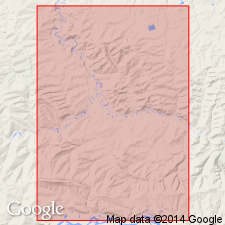
- Usage in publication:
-
- Killik tongue*
- Modifications:
-
- Areal extent
- AAPG geologic province:
-
- Alaska Northern region
Summary:
Killik tongue of Chandler formation present in Titaluk test well No.1 and in Knifeblade test wells. Age is given as Early Cretaceous.
Source: GNU records (USGS DDS-6; Menlo GNULEX).
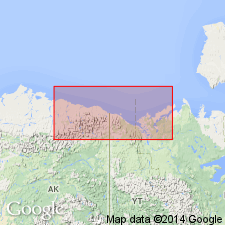
- Usage in publication:
-
- Killik Tongue*
- Modifications:
-
- Age modified
- Biostratigraphic dating
- AAPG geologic province:
-
- Alaska Northern region
Summary:
In Umiat test well 11 of Naval Petroleum Reserve in Alaska, age of dinoflagellate and acritarch assemblages from Killik Tongue of Chandler Formation range in age from middle Albian to early Cenomanian(?). [On this basis age of tongue is Early and Late(?) Cretaceous in eastern North Slope area.]
Source: GNU records (USGS DDS-6; Menlo GNULEX).
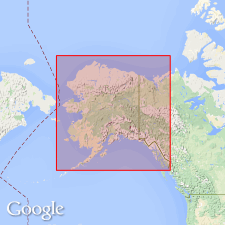
- Usage in publication:
-
- Killik Tongue*
- Modifications:
-
- Age modified
- AAPG geologic province:
-
- Alaska Northern region
Summary:
Age is Early and Late Cretaceous based on placement of Albian-Cenomanian boundary in middle part of Killik Tongue of Chandler Formation of Nanushuk Group on basis of mega- and microfossil evidence [Smiley, 1969] and marine microfossil data [Sliter, 1969].
Source: GNU records (USGS DDS-6; Menlo GNULEX).
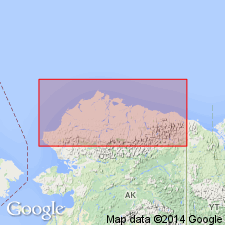
- Usage in publication:
-
- Killik Tongue*
- Modifications:
-
- Age modified
- AAPG geologic province:
-
- Alaska Northern region
Summary:
Albian-Cenomanian boundary may lie at base of Killik tongue "upper part" or in uppermost part of Killik tongue "lower part" based on Foraminifera (Sliter, 1979) and paleobotanical evidence (Spicer and Parrish, 1986).
Source: GNU records (USGS DDS-6; Menlo GNULEX).
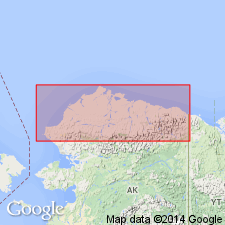
- Usage in publication:
-
- Killik Tongue†
- Modifications:
-
- Abandoned
- AAPG geologic province:
-
- Alaska Northern region
Summary:
Pg. 5 (fig. 4), 6-8 (table 1), 12. †Killik Tongue of †Chandler Formation of Nanushuk Group. Abandoned. (†Chandler also abandoned.) Rocks reassigned to unnamed upper part (nonmarine) of Nanushuk Formation (revised). [See Nanushuk.]
Source: Publication.
For more information, please contact Nancy Stamm, Geologic Names Committee Secretary.
Asterisk (*) indicates published by U.S. Geological Survey authors.
"No current usage" (†) implies that a name has been abandoned or has fallen into disuse. Former usage and, if known, replacement name given in parentheses ( ).
Slash (/) indicates name conflicts with nomenclatural guidelines (CSN, 1933; ACSN, 1961, 1970; NACSN, 1983, 2005, 2021). May be explained within brackets ([ ]).

